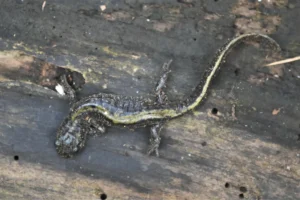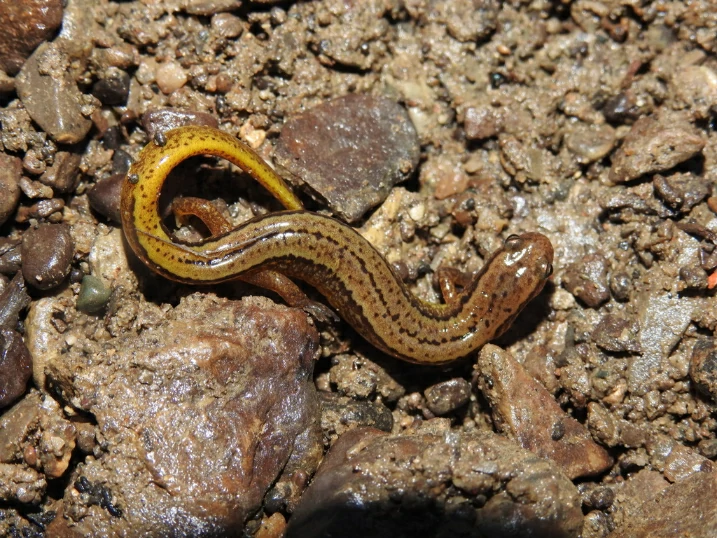When you see a salamander, its long body and tail might remind you of a snake or a lizard. But beneath that soft, smooth skin, does it have a backbone like other animals? The simple answer is yes, salamanders do have backbones.
Salamanders are vertebrates, which means they have a spine made of many small bones called vertebrae. This backbone supports their bodies, protects their spinal cord, and allows them to move smoothly on land and in water.
What Makes an Animal Have a Backbone?
Animals with backbones are called vertebrates. This is a big group that includes fish, birds, reptiles, mammals, and amphibians. Salamanders belong to the amphibian group.

Animals without backbones are called invertebrates. This group includes insects, worms, spiders, and jellyfish. These animals have different ways to support their bodies.
The backbone is also called the spine or vertebral column. It runs down the middle of the body from the head to the tail. The backbone is made up of many small bones called vertebrae. These bones stack on top of each other like building blocks.
Inside the backbone is something very important called the spinal cord.
This is a bundle of nerves that carries messages between the brain and the rest of the body. The backbone protects this delicate nerve bundle.
How is a Salamander’s Backbone Built?
A salamander’s backbone has three main parts. Each part does a different job.
The first part is near the head. These are called cervical vertebrae. They support the head and neck. They let the salamander move its head up and down and side to side.

The middle part makes up most of the body. These are called trunk vertebrae. They support the ribs and the main body. This is the longest section of the backbone.
The last part runs through the tail. These are called caudal vertebrae. They help the salamander swim and keep its balance.
Different types of salamanders have different numbers of vertebrae. Some have more than 50 vertebrae. This is more than many other amphibians and reptiles have.
The salamander’s backbone is very flexible. It is not stiff like the backbone in many mammals. This flexibility is important because salamanders need to move in many different ways.
They crawl on land. They swim in water. They squeeze through tight spaces. A flexible backbone makes all of this possible.
Why Do Salamanders Need Backbones?
The backbone does several important jobs for salamanders.
First, it helps with movement. Muscles attach to the backbone. When these muscles squeeze and relax, they make the backbone bend and twist. This is how salamanders crawl and swim. Without a backbone, their muscles would have nothing solid to pull against.
Second, the backbone protects the spinal cord. The spinal cord is like a highway for nerve signals. It carries messages from the brain to the arms, legs, and tail.

It also carries messages back to the brain. If the spinal cord gets damaged, the salamander cannot move properly. The hard bones of the backbone keep the soft spinal cord safe.
Third, the backbone gives the body structure. Without it, salamanders would be like soft, floppy bags. They could not hold their shape. They could not stand up or swim in straight lines.
Fourth, the backbone helps control the tail. Salamanders use their tails for swimming and balance. The backbone runs all the way through the tail. This gives the salamander precise control over tail movements.
The Amazing Ability to Regrow
One of the most interesting things about salamanders is that they can regrow lost body parts. If a predator grabs a salamander’s tail, the tail breaks off. The salamander escapes, and later it grows a new tail.
The backbone plays a role in this process too. When the tail breaks off, the vertebrae at the break do not grow back exactly the same. Instead, a simpler structure forms in the new tail. This new structure is more like a rod than separate vertebrae.

Even though the new backbone structure is simpler, it still works well. The salamander can swim and move normally with its new tail. The spinal cord also grows back partially. This helps the new tail function properly.
Scientists study this ability because it is so unusual. Most animals cannot regrow lost body parts. Understanding how salamanders do this might help humans learn to heal better from injuries.
Do Salamanders Have Skulls?
Yes, salamanders have skulls that protect their brains. The skull connects to the top of the backbone. It is made of many bones that fit together tightly.
Salamander skulls are different from reptile skulls. They are lighter and more flexible. This helps salamanders open their mouths very wide when they catch prey. It also makes their heads more flexible overall.
The skull and backbone work together to form the main support structure for the whole body.
How Do Salamander Backbones Compare to Other Animals?
Salamanders are amphibians. This means they share some features with fish and some features with reptiles.
Like fish, salamanders have long, flexible spines with many similar vertebrae. This helps them swim smoothly through water.
Like lizards and other reptiles, salamanders have arms and legs that connect to their backbone. The connection happens through structures called the shoulder girdle and pelvic girdle.
Unlike many reptiles, salamanders have fewer ribs and softer skeletons overall. This matches their moist, flexible lifestyle. They live in damp places and need to squeeze through small spaces.
This combination of features makes sense for their lifestyle. Salamanders live both in water and on land. Their backbones help them succeed in both environments.
What Happens When the Backbone Gets Hurt?
Because the backbone protects the spinal cord, injuries can be very serious. If the spinal cord gets damaged, salamanders can lose the ability to move. They might become paralyzed.
Salamanders can get hurt by predators, accidents, or dangerous things in their habitat. However, they are better at healing than many other animals. They cannot perfectly regrow damaged vertebrae, but they can heal some minor spinal injuries better than most animals can.
Still, serious spinal injuries are usually fatal for salamanders. This is why protecting their habitat is so important.
What This Means for People Who Keep Pet Salamanders
If you have a pet salamander, you need to protect its backbone. Salamanders have delicate bones that can break if they fall or get squeezed too hard.
Handle your salamander very gently if you must touch it at all. Most experts recommend not handling salamanders unless absolutely necessary.
Make sure the tank has soft decorations without sharp edges. Do not overcrowd the habitat. This reduces the chance of injuries.
Watch how your salamander moves. You can see its spine flex as it walks or swims. This shows how the backbone supports its movement.
Conclusion
So do salamanders have backbones? Yes, they absolutely do. Their long, flexible spines support their bodies, protect their spinal cords, and allow them to move smoothly both in water and on land.
This backbone is one of many reasons why salamanders are such interesting animals. They may look simple on the outside, but they have complex and amazing biology on the inside.
Whether you see one in a forest stream or care for one as a pet, remember that underneath that soft skin is a strong and flexible spine. This backbone is key to understanding how these quiet, resilient creatures live their unique lives.
The next time you encounter a salamander, you will know that it is a vertebrate just like you. It has a backbone that helps it survive and thrive in its watery, woodland world.
Hi, my name is Ezra Mushala, i have been interested animals all my life. I am the main author and editor here at snakeinformer.com.

